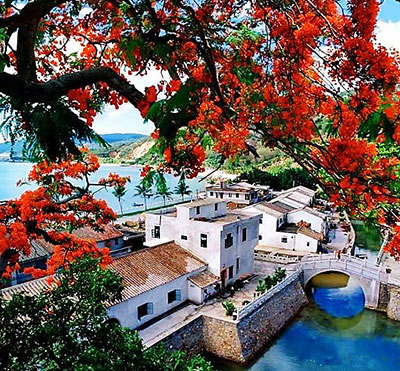
NOT long ago, the Ministry of Agriculture of the People’s Republic of China released a list recognizing the entities responsible for creating recreational fishery brands in which 27 villages were given the honorary title “Most Beautiful Village.” Among them, you can find Da’ao Fishing Village in Yangjiang, Guangdong Province. Da’ao Fishing Village, located in the southeast of Dongping Township in Yangdong County, is an ancient fishing port with a history of more than 1,000 years. It used to serve as a main seaport in ancient South China. The fishing village is a rarity in Guangdong, where ancient styles and artifacts remain until today, fully represented by numerous relics and bearing testimony to its time-honored history. With a touch of antique flavor, the village is also endowed with picturesque scenery. Approaching the village, which is embraced by a gulf, you will be immediately enraptured by its unique charm. Over 80 ancient houses belonging to fishers dating back to the Ming (1386-1644) and Qing (1644-1911) dynasties are well preserved here. Looking ahead, you’ll see a familiar picture formed by a clear blue sea, berthed fishing boats and old men sitting at the doors of fishing huts, knitting fishing nets with traditional methods while tranquilly gazing at the boats and waves at the sea. Once a main port of the Maritime Silk Road, the village is now home to historical blockhouses and former sites of chambers of commerce and ethnic club houses, making it a nice choice for sightseeing history lovers. With four sides surrounded by mountains and two by water, Da’ao Fishing Village can only be approached via a coastal highway, preserving its identity as a land of idyllic beauty, hardly disturbed by the bustling outside world. On either side of the village’s old streets stand folk houses which used to be shops in ancient times. The front side of the houses looks akin to shops in Suzhou and Hangzhou while the back side resembles houseboats. Among the folk houses, one two-story Western-style building stands out. It’s the former site of the Da’ao Chamber of Commerce. Apart from its nice design, the building has a strong construction with thick walls. It’s said that at the end of the Ming Dynasty and the beginning of the Qing Dynasty, the society was in total chaos. Da’ao, which was far away from the central government with no one willing to administer on its behalf, was a victim of the chaos and became a target of thieves. As a result, from 1912 to 1961, urged by the Chamber of Commerce of the Republic of China, the heads of families joined hands and set up loopholes in the vicinity of the treasury of the chamber of commerce. Whenever pirates entered the village, villagers hid their families in the treasury, protecting them and their property. Walking past the buildings of the chamber of commerce toward the end of the village, a peach leaf-shaped building sits in front of you. It is the folk custom museum of Da’ao Fishing Village, which is said to be the first one in the country. A collection of precious shells, fishery harvesting products, large marine mammal skeletons and imitations of wooden boats from the Song Dynasty (960-1279) is sure to whisk your imagination away to a time long ago. The museum houses over 5,000 pieces of fishing gear, production and marriage artifacts. What cannot be missed are the compilations of the history and stories of fishers and the series of sculptures depicting fishing organized here. Transportation: Buses to Yangjiang depart from long-distance bus stations in Futian, Longgang, Longhua as well as Qiaoshe Bus Station and Yinhu Bus Station. Bus tickets range from 100 yuan to 130 yuan and the bus ride takes around five hours. Take another bus from Chengnan Bus Station in Yangjiang to Dongping Township. The ride takes 40 minutes and costs 10 yuan for each person. Then take a taxi to Da’ao Fishing Village. (Chen Xiaochun) | 
